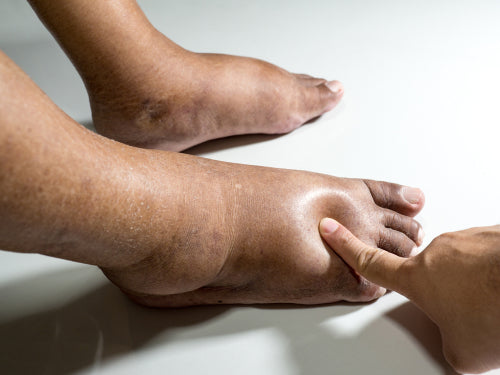How Proper Leg Elevation Works to Improve Edema
Edema–or swelling–can cause tenderness, limited mobility and even pain. While some cases of edema are very serious and require assistance from a medical professional, many of the common, milder cases can be addressed at home with leg elevation. Read on to learn everything you need to know about treating edema with leg elevation.

What Is Edema?
“Edema” is a medical term that refers to fluid retention, or swelling, in the body. It usually occurs in the feet, ankles and legs because gravity pulls blood and other bodily fluids towards the lower extremities. However, edema may occur anywhere on the body.
Edema ranges from mild and temporary to severe and chronic. It may be caused by a variety of reasons, including eating too much salt, sunburn, heart failure, kidney disease, liver problems and cirrhosis, pregnancy, lymph nodes issues, certain medications and standing or walking a lot in hot weather.
There are many different types of edema: peripheral edema (occurring in the legs or arms), pedal edema (occurring in the feet and lower legs), lymphedema (caused by blockage in or damage to the lymphatic system), pulmonary edema (a serious condition that occurs when fluid collects in the sacs of your lungs), cerebral edema (a very serious condition that occurs when fluid builds up in the brain), and macular edema (occurring when fluids builds up in your eye).
The last three conditions are rare but very serious, and you should immediately get professional medical help if you experience signs of fluid buildup in these areas. Thankfully, most instances of edema do not fall into these categories and can often be treated successfully with at-home remedies, such as leg elevation.

Why Leg Elevation Helps Edema
If you’ve ever sprained an ankle, you probably followed the classic acronym RICE to take care of it: rest, ice, compression and elevating the limb above the heart. Even if you’re not sure why or how elevation works, you know that it’s a key strategy to reducing swelling in the legs.
When it comes to discouraging fluid buildup in your lower body, gravity usually is not your friend. Yes, this force keeps us anchored to the earth and allows for life as we know it, but it also exerts a really strong pull on your body fluids and encourages them to pool in your lower limbs. This is why edema occurs more frequently in the lower body than the upper body: Gravity is trying to pull fluid from your upper body down to your lower body, hence why your feet might swell on a hot day while your hands remain the same.
Leg elevation helps edema in the legs because it places the affected limb or limbs above the level of the heart, which allows gravity to work with you rather than against you. If you assume the proper position, gravity will encourage fluid to drain from the place of highest elevation (your legs) back to the place of lowest elevation (your core and upper body). However, leg elevation must be done properly in order to reduce edema; otherwise, it won’t help and can even hurt. In the final section, we cover proper leg elevation techniques for edema.

How to Properly Elevate Your Legs for Edema
First of all, you should lie flat on your back on a comfortable couch or bed that accommodates your full height—don’t scrunch yourself up! If you can’t lie flat on your back for some reason, a proper contour pillow for the upper body can help you assume the position without putting extra pressure on your neck and back.
As for the legs, your thighs should be tilted at a 40-degree angle for maximum comfort and venous flow. Your knees should be bent at 25 degrees so as not to put too much stress on the tendons. Finally, the calves should be tilted at 15 degrees to allow gravity to gently drain blood and fluid back towards the core.
If this sounds like too many numbers to remember, the Lounge Doctor Leg Rest will automatically guide your body in the proper leg elevation position each and every time with no effort on your part. The Lounge Doctor Leg Rest is the only patented leg rest that positions the legs correctly to increase blood flow in the veins and help provide relief from edema. Leg elevation will only help if done so correctly. That's why the Lounge Doctor Leg Rest was invented.
If you follow these instructions for proper leg elevation, you’ll probably experience relief of your edema in only a short time. Remember: If your edema is chronic or recurring, you’ll need to use a leg elevation pillow consistently in order to maintain your results.



